Nestle's Enterprise Resource Planning (ERP) Implementation Report
VerifiedAdded on 2020/03/23
|14
|4114
|36
Report
AI Summary
This report provides a comprehensive overview of Nestle's Enterprise Resource Planning (ERP) implementation. It outlines the various stages of the process, including planning, design, development, testing, evaluation, and optimization. The report begins with an executive summary and an introduction that establishes the business case for ERP implementation, highlighting Nestle's objectives to standardize operations and integrate business processes. It then delves into the preliminary design phase, covering problem identification, scope definition, and infrastructure checks. The subsequent sections detail system design and development, strategic planning, procedure review, and system selection, with a focus on Nestle's decision to implement SAP. The report further explores system installation, data migration, testing, evaluation, and optimization, providing a complete roadmap of the ERP implementation journey. Recommendations are provided to ensure a successful ERP implementation. The report emphasizes the importance of thorough planning, feasibility studies, and the alignment of the ERP system with business objectives to achieve improved workflow, data accuracy, and cost efficiency.
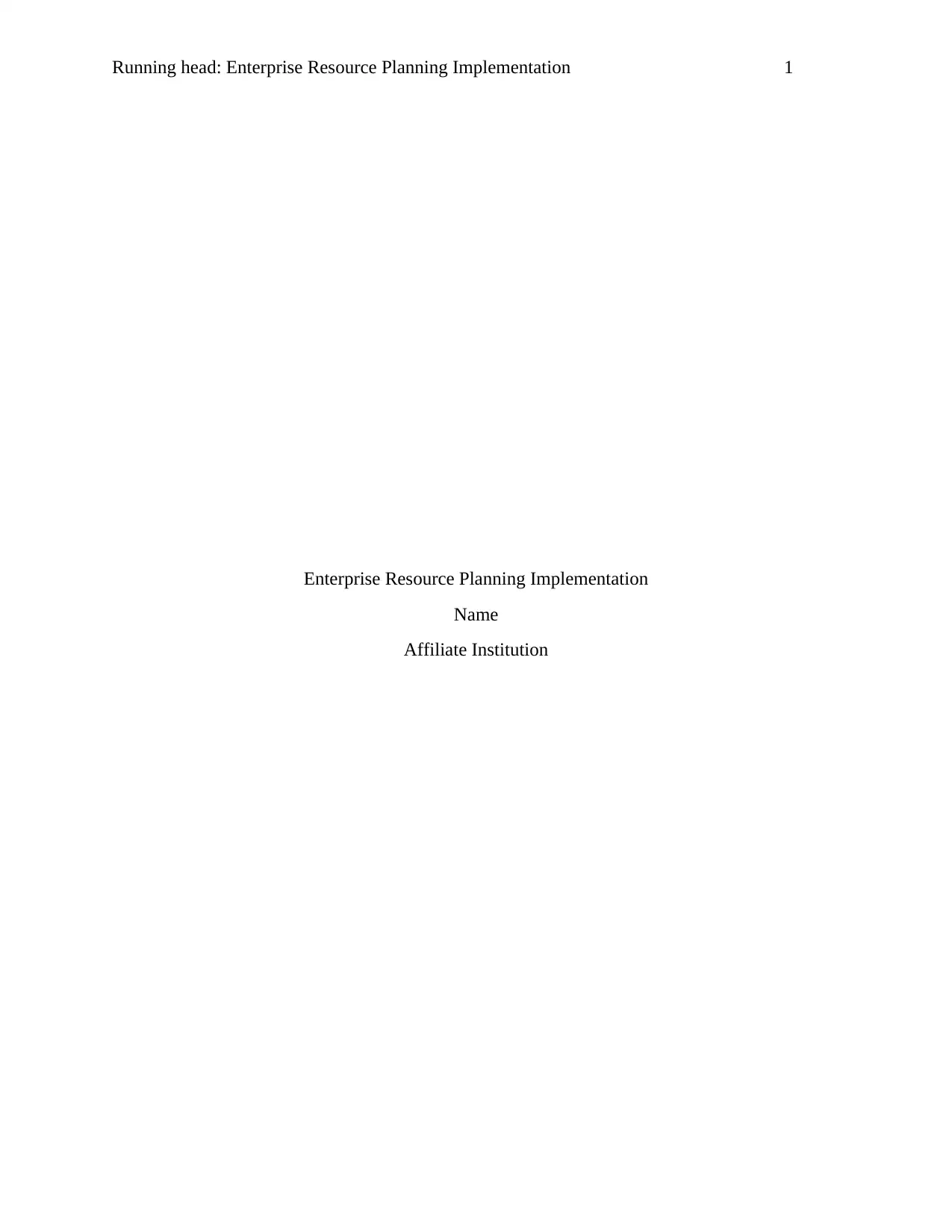
Running head: Enterprise Resource Planning Implementation 1
Enterprise Resource Planning Implementation
Name
Affiliate Institution
Enterprise Resource Planning Implementation
Name
Affiliate Institution
Paraphrase This Document
Need a fresh take? Get an instant paraphrase of this document with our AI Paraphraser
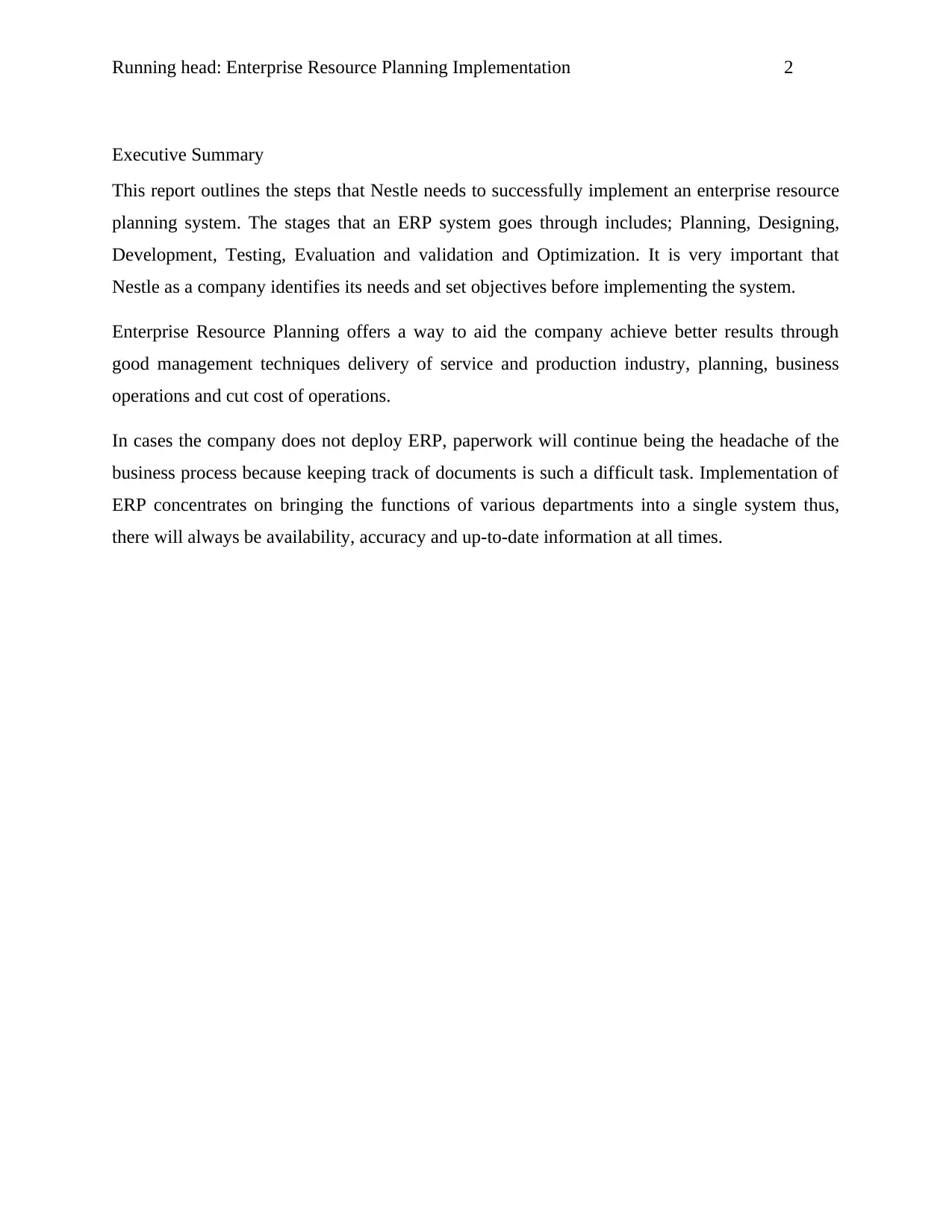
Running head: Enterprise Resource Planning Implementation 2
Executive Summary
This report outlines the steps that Nestle needs to successfully implement an enterprise resource
planning system. The stages that an ERP system goes through includes; Planning, Designing,
Development, Testing, Evaluation and validation and Optimization. It is very important that
Nestle as a company identifies its needs and set objectives before implementing the system.
Enterprise Resource Planning offers a way to aid the company achieve better results through
good management techniques delivery of service and production industry, planning, business
operations and cut cost of operations.
In cases the company does not deploy ERP, paperwork will continue being the headache of the
business process because keeping track of documents is such a difficult task. Implementation of
ERP concentrates on bringing the functions of various departments into a single system thus,
there will always be availability, accuracy and up-to-date information at all times.
Executive Summary
This report outlines the steps that Nestle needs to successfully implement an enterprise resource
planning system. The stages that an ERP system goes through includes; Planning, Designing,
Development, Testing, Evaluation and validation and Optimization. It is very important that
Nestle as a company identifies its needs and set objectives before implementing the system.
Enterprise Resource Planning offers a way to aid the company achieve better results through
good management techniques delivery of service and production industry, planning, business
operations and cut cost of operations.
In cases the company does not deploy ERP, paperwork will continue being the headache of the
business process because keeping track of documents is such a difficult task. Implementation of
ERP concentrates on bringing the functions of various departments into a single system thus,
there will always be availability, accuracy and up-to-date information at all times.
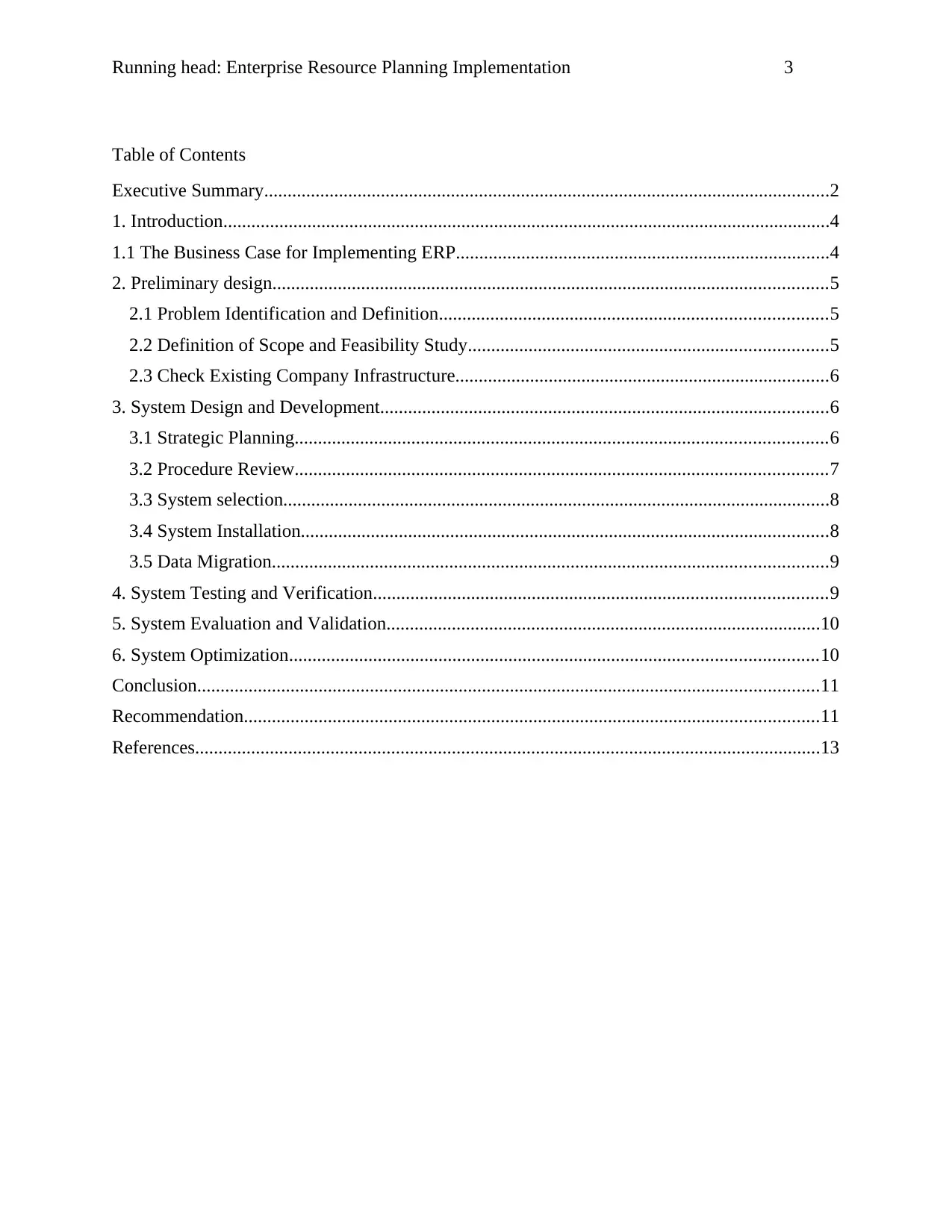
Running head: Enterprise Resource Planning Implementation 3
Table of Contents
Executive Summary.........................................................................................................................2
1. Introduction..................................................................................................................................4
1.1 The Business Case for Implementing ERP................................................................................4
2. Preliminary design.......................................................................................................................5
2.1 Problem Identification and Definition...................................................................................5
2.2 Definition of Scope and Feasibility Study.............................................................................5
2.3 Check Existing Company Infrastructure................................................................................6
3. System Design and Development................................................................................................6
3.1 Strategic Planning..................................................................................................................6
3.2 Procedure Review..................................................................................................................7
3.3 System selection.....................................................................................................................8
3.4 System Installation.................................................................................................................8
3.5 Data Migration.......................................................................................................................9
4. System Testing and Verification.................................................................................................9
5. System Evaluation and Validation.............................................................................................10
6. System Optimization.................................................................................................................10
Conclusion.....................................................................................................................................11
Recommendation...........................................................................................................................11
References......................................................................................................................................13
Table of Contents
Executive Summary.........................................................................................................................2
1. Introduction..................................................................................................................................4
1.1 The Business Case for Implementing ERP................................................................................4
2. Preliminary design.......................................................................................................................5
2.1 Problem Identification and Definition...................................................................................5
2.2 Definition of Scope and Feasibility Study.............................................................................5
2.3 Check Existing Company Infrastructure................................................................................6
3. System Design and Development................................................................................................6
3.1 Strategic Planning..................................................................................................................6
3.2 Procedure Review..................................................................................................................7
3.3 System selection.....................................................................................................................8
3.4 System Installation.................................................................................................................8
3.5 Data Migration.......................................................................................................................9
4. System Testing and Verification.................................................................................................9
5. System Evaluation and Validation.............................................................................................10
6. System Optimization.................................................................................................................10
Conclusion.....................................................................................................................................11
Recommendation...........................................................................................................................11
References......................................................................................................................................13
⊘ This is a preview!⊘
Do you want full access?
Subscribe today to unlock all pages.

Trusted by 1+ million students worldwide
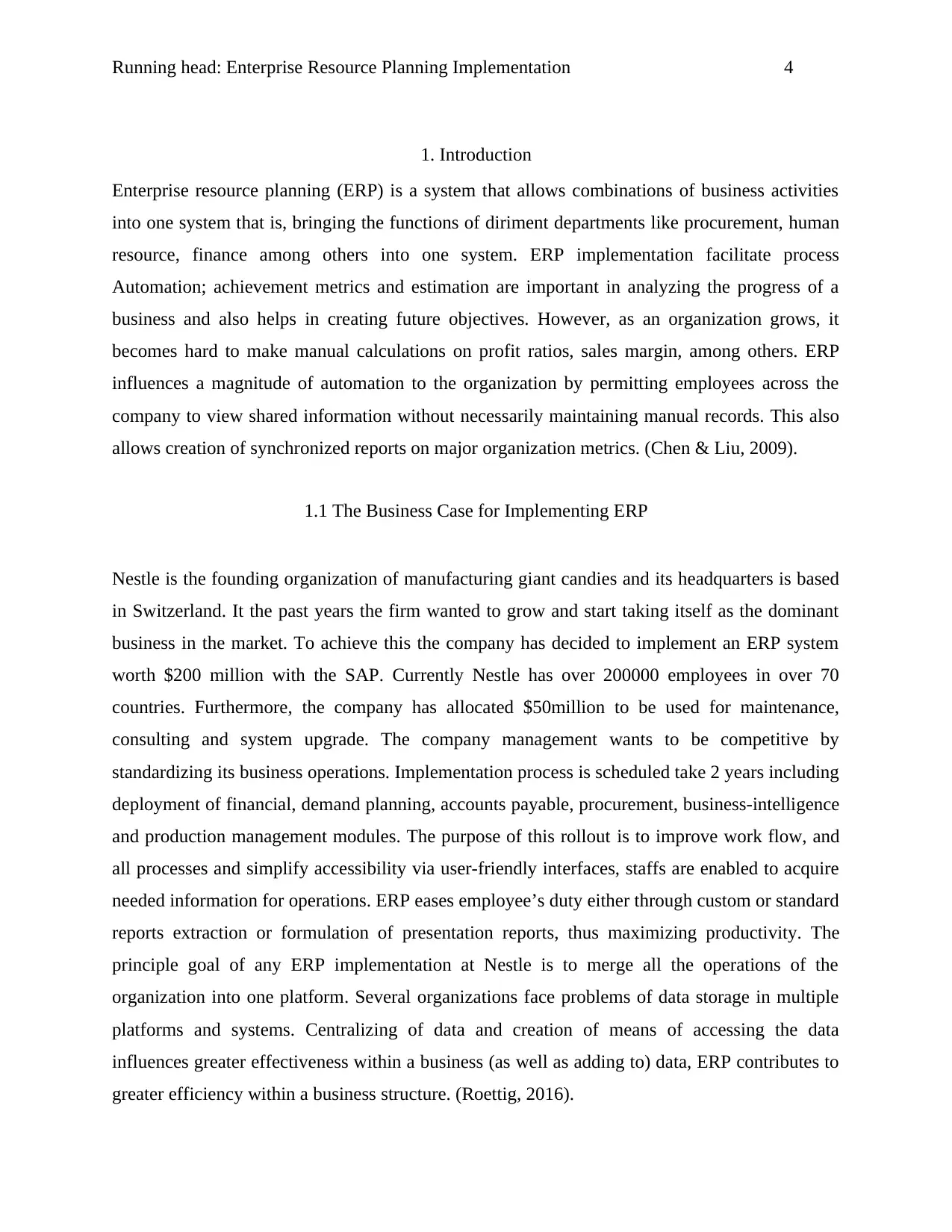
Running head: Enterprise Resource Planning Implementation 4
1. Introduction
Enterprise resource planning (ERP) is a system that allows combinations of business activities
into one system that is, bringing the functions of diriment departments like procurement, human
resource, finance among others into one system. ERP implementation facilitate process
Automation; achievement metrics and estimation are important in analyzing the progress of a
business and also helps in creating future objectives. However, as an organization grows, it
becomes hard to make manual calculations on profit ratios, sales margin, among others. ERP
influences a magnitude of automation to the organization by permitting employees across the
company to view shared information without necessarily maintaining manual records. This also
allows creation of synchronized reports on major organization metrics. (Chen & Liu, 2009).
1.1 The Business Case for Implementing ERP
Nestle is the founding organization of manufacturing giant candies and its headquarters is based
in Switzerland. It the past years the firm wanted to grow and start taking itself as the dominant
business in the market. To achieve this the company has decided to implement an ERP system
worth $200 million with the SAP. Currently Nestle has over 200000 employees in over 70
countries. Furthermore, the company has allocated $50million to be used for maintenance,
consulting and system upgrade. The company management wants to be competitive by
standardizing its business operations. Implementation process is scheduled take 2 years including
deployment of financial, demand planning, accounts payable, procurement, business-intelligence
and production management modules. The purpose of this rollout is to improve work flow, and
all processes and simplify accessibility via user-friendly interfaces, staffs are enabled to acquire
needed information for operations. ERP eases employee’s duty either through custom or standard
reports extraction or formulation of presentation reports, thus maximizing productivity. The
principle goal of any ERP implementation at Nestle is to merge all the operations of the
organization into one platform. Several organizations face problems of data storage in multiple
platforms and systems. Centralizing of data and creation of means of accessing the data
influences greater effectiveness within a business (as well as adding to) data, ERP contributes to
greater efficiency within a business structure. (Roettig, 2016).
1. Introduction
Enterprise resource planning (ERP) is a system that allows combinations of business activities
into one system that is, bringing the functions of diriment departments like procurement, human
resource, finance among others into one system. ERP implementation facilitate process
Automation; achievement metrics and estimation are important in analyzing the progress of a
business and also helps in creating future objectives. However, as an organization grows, it
becomes hard to make manual calculations on profit ratios, sales margin, among others. ERP
influences a magnitude of automation to the organization by permitting employees across the
company to view shared information without necessarily maintaining manual records. This also
allows creation of synchronized reports on major organization metrics. (Chen & Liu, 2009).
1.1 The Business Case for Implementing ERP
Nestle is the founding organization of manufacturing giant candies and its headquarters is based
in Switzerland. It the past years the firm wanted to grow and start taking itself as the dominant
business in the market. To achieve this the company has decided to implement an ERP system
worth $200 million with the SAP. Currently Nestle has over 200000 employees in over 70
countries. Furthermore, the company has allocated $50million to be used for maintenance,
consulting and system upgrade. The company management wants to be competitive by
standardizing its business operations. Implementation process is scheduled take 2 years including
deployment of financial, demand planning, accounts payable, procurement, business-intelligence
and production management modules. The purpose of this rollout is to improve work flow, and
all processes and simplify accessibility via user-friendly interfaces, staffs are enabled to acquire
needed information for operations. ERP eases employee’s duty either through custom or standard
reports extraction or formulation of presentation reports, thus maximizing productivity. The
principle goal of any ERP implementation at Nestle is to merge all the operations of the
organization into one platform. Several organizations face problems of data storage in multiple
platforms and systems. Centralizing of data and creation of means of accessing the data
influences greater effectiveness within a business (as well as adding to) data, ERP contributes to
greater efficiency within a business structure. (Roettig, 2016).
Paraphrase This Document
Need a fresh take? Get an instant paraphrase of this document with our AI Paraphraser
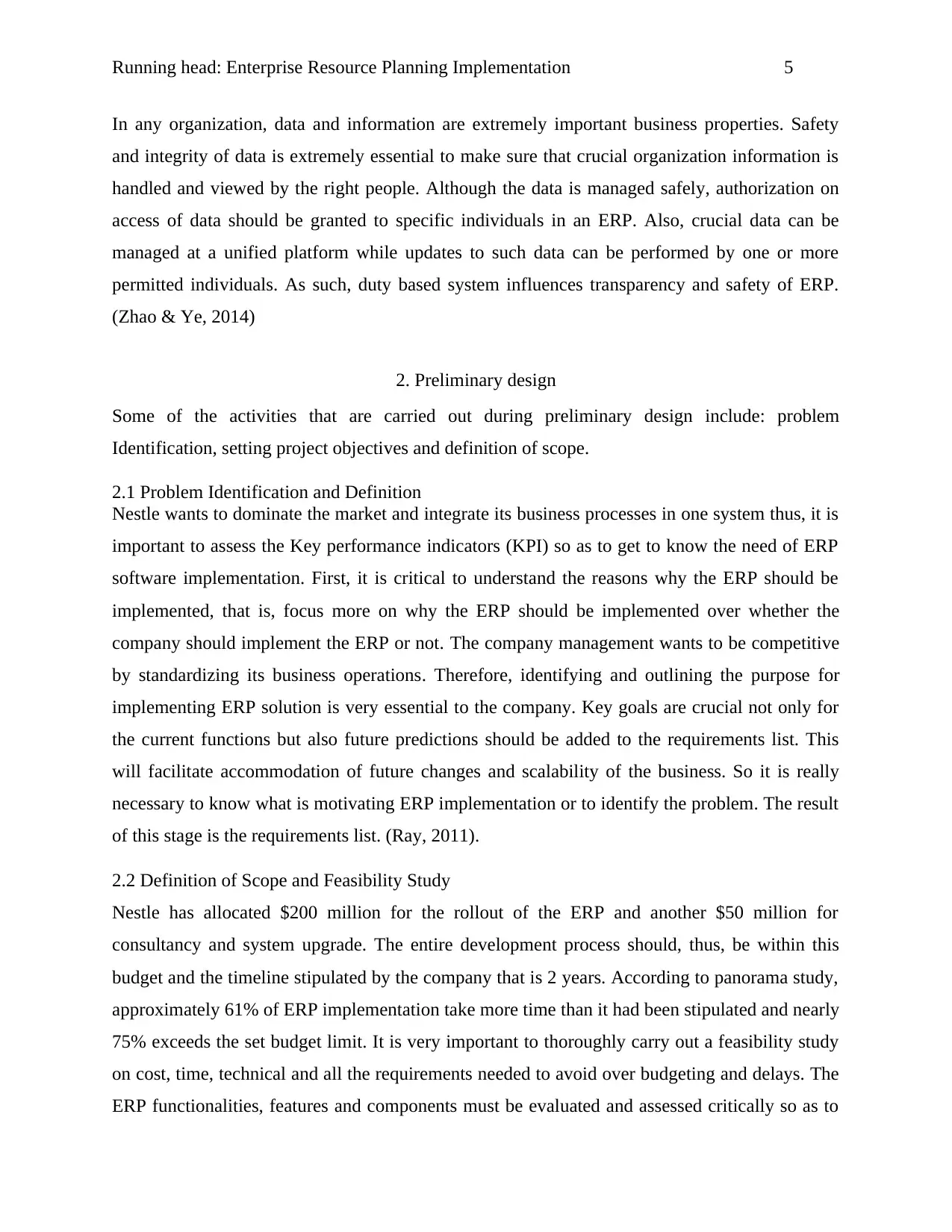
Running head: Enterprise Resource Planning Implementation 5
In any organization, data and information are extremely important business properties. Safety
and integrity of data is extremely essential to make sure that crucial organization information is
handled and viewed by the right people. Although the data is managed safely, authorization on
access of data should be granted to specific individuals in an ERP. Also, crucial data can be
managed at a unified platform while updates to such data can be performed by one or more
permitted individuals. As such, duty based system influences transparency and safety of ERP.
(Zhao & Ye, 2014)
2. Preliminary design
Some of the activities that are carried out during preliminary design include: problem
Identification, setting project objectives and definition of scope.
2.1 Problem Identification and Definition
Nestle wants to dominate the market and integrate its business processes in one system thus, it is
important to assess the Key performance indicators (KPI) so as to get to know the need of ERP
software implementation. First, it is critical to understand the reasons why the ERP should be
implemented, that is, focus more on why the ERP should be implemented over whether the
company should implement the ERP or not. The company management wants to be competitive
by standardizing its business operations. Therefore, identifying and outlining the purpose for
implementing ERP solution is very essential to the company. Key goals are crucial not only for
the current functions but also future predictions should be added to the requirements list. This
will facilitate accommodation of future changes and scalability of the business. So it is really
necessary to know what is motivating ERP implementation or to identify the problem. The result
of this stage is the requirements list. (Ray, 2011).
2.2 Definition of Scope and Feasibility Study
Nestle has allocated $200 million for the rollout of the ERP and another $50 million for
consultancy and system upgrade. The entire development process should, thus, be within this
budget and the timeline stipulated by the company that is 2 years. According to panorama study,
approximately 61% of ERP implementation take more time than it had been stipulated and nearly
75% exceeds the set budget limit. It is very important to thoroughly carry out a feasibility study
on cost, time, technical and all the requirements needed to avoid over budgeting and delays. The
ERP functionalities, features and components must be evaluated and assessed critically so as to
In any organization, data and information are extremely important business properties. Safety
and integrity of data is extremely essential to make sure that crucial organization information is
handled and viewed by the right people. Although the data is managed safely, authorization on
access of data should be granted to specific individuals in an ERP. Also, crucial data can be
managed at a unified platform while updates to such data can be performed by one or more
permitted individuals. As such, duty based system influences transparency and safety of ERP.
(Zhao & Ye, 2014)
2. Preliminary design
Some of the activities that are carried out during preliminary design include: problem
Identification, setting project objectives and definition of scope.
2.1 Problem Identification and Definition
Nestle wants to dominate the market and integrate its business processes in one system thus, it is
important to assess the Key performance indicators (KPI) so as to get to know the need of ERP
software implementation. First, it is critical to understand the reasons why the ERP should be
implemented, that is, focus more on why the ERP should be implemented over whether the
company should implement the ERP or not. The company management wants to be competitive
by standardizing its business operations. Therefore, identifying and outlining the purpose for
implementing ERP solution is very essential to the company. Key goals are crucial not only for
the current functions but also future predictions should be added to the requirements list. This
will facilitate accommodation of future changes and scalability of the business. So it is really
necessary to know what is motivating ERP implementation or to identify the problem. The result
of this stage is the requirements list. (Ray, 2011).
2.2 Definition of Scope and Feasibility Study
Nestle has allocated $200 million for the rollout of the ERP and another $50 million for
consultancy and system upgrade. The entire development process should, thus, be within this
budget and the timeline stipulated by the company that is 2 years. According to panorama study,
approximately 61% of ERP implementation take more time than it had been stipulated and nearly
75% exceeds the set budget limit. It is very important to thoroughly carry out a feasibility study
on cost, time, technical and all the requirements needed to avoid over budgeting and delays. The
ERP functionalities, features and components must be evaluated and assessed critically so as to
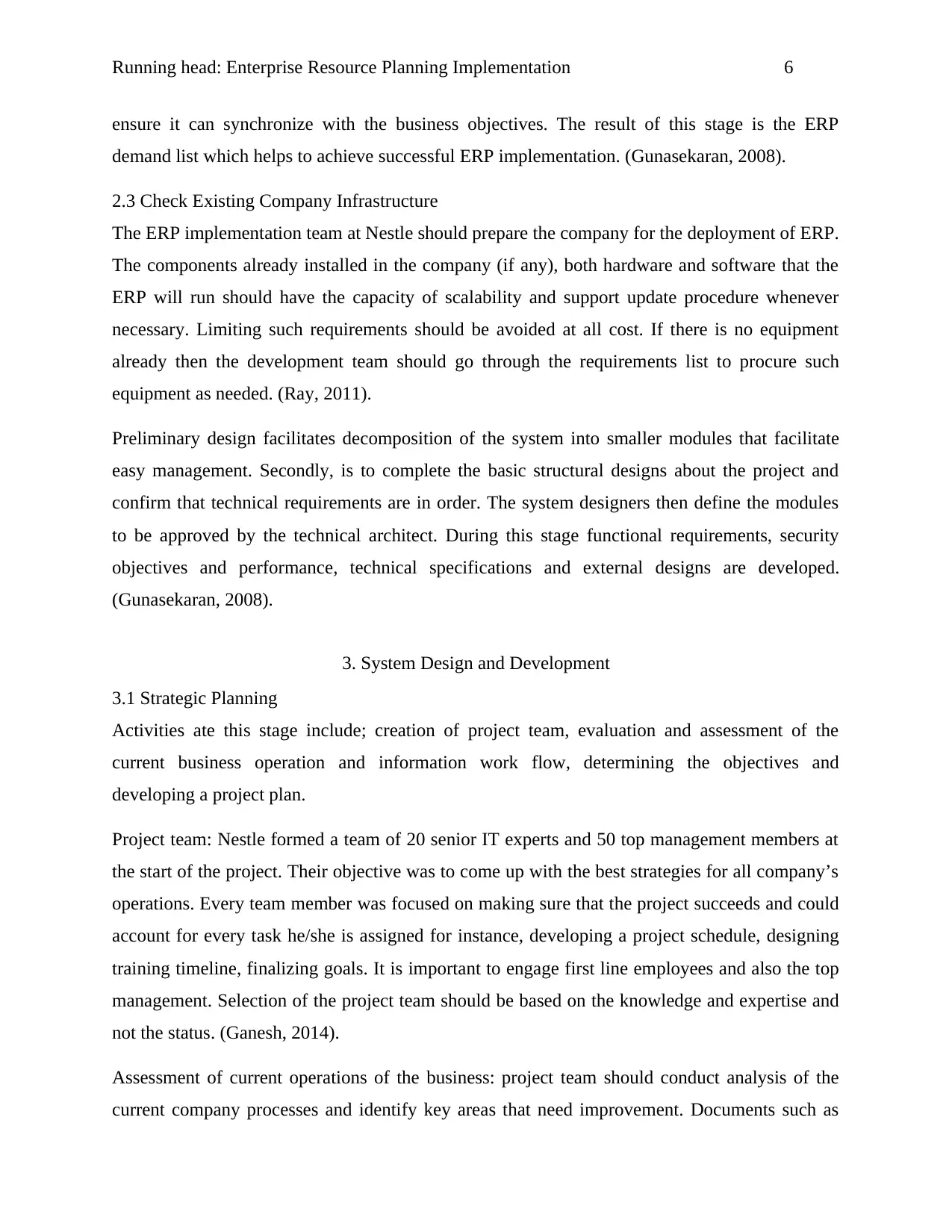
Running head: Enterprise Resource Planning Implementation 6
ensure it can synchronize with the business objectives. The result of this stage is the ERP
demand list which helps to achieve successful ERP implementation. (Gunasekaran, 2008).
2.3 Check Existing Company Infrastructure
The ERP implementation team at Nestle should prepare the company for the deployment of ERP.
The components already installed in the company (if any), both hardware and software that the
ERP will run should have the capacity of scalability and support update procedure whenever
necessary. Limiting such requirements should be avoided at all cost. If there is no equipment
already then the development team should go through the requirements list to procure such
equipment as needed. (Ray, 2011).
Preliminary design facilitates decomposition of the system into smaller modules that facilitate
easy management. Secondly, is to complete the basic structural designs about the project and
confirm that technical requirements are in order. The system designers then define the modules
to be approved by the technical architect. During this stage functional requirements, security
objectives and performance, technical specifications and external designs are developed.
(Gunasekaran, 2008).
3. System Design and Development
3.1 Strategic Planning
Activities ate this stage include; creation of project team, evaluation and assessment of the
current business operation and information work flow, determining the objectives and
developing a project plan.
Project team: Nestle formed a team of 20 senior IT experts and 50 top management members at
the start of the project. Their objective was to come up with the best strategies for all company’s
operations. Every team member was focused on making sure that the project succeeds and could
account for every task he/she is assigned for instance, developing a project schedule, designing
training timeline, finalizing goals. It is important to engage first line employees and also the top
management. Selection of the project team should be based on the knowledge and expertise and
not the status. (Ganesh, 2014).
Assessment of current operations of the business: project team should conduct analysis of the
current company processes and identify key areas that need improvement. Documents such as
ensure it can synchronize with the business objectives. The result of this stage is the ERP
demand list which helps to achieve successful ERP implementation. (Gunasekaran, 2008).
2.3 Check Existing Company Infrastructure
The ERP implementation team at Nestle should prepare the company for the deployment of ERP.
The components already installed in the company (if any), both hardware and software that the
ERP will run should have the capacity of scalability and support update procedure whenever
necessary. Limiting such requirements should be avoided at all cost. If there is no equipment
already then the development team should go through the requirements list to procure such
equipment as needed. (Ray, 2011).
Preliminary design facilitates decomposition of the system into smaller modules that facilitate
easy management. Secondly, is to complete the basic structural designs about the project and
confirm that technical requirements are in order. The system designers then define the modules
to be approved by the technical architect. During this stage functional requirements, security
objectives and performance, technical specifications and external designs are developed.
(Gunasekaran, 2008).
3. System Design and Development
3.1 Strategic Planning
Activities ate this stage include; creation of project team, evaluation and assessment of the
current business operation and information work flow, determining the objectives and
developing a project plan.
Project team: Nestle formed a team of 20 senior IT experts and 50 top management members at
the start of the project. Their objective was to come up with the best strategies for all company’s
operations. Every team member was focused on making sure that the project succeeds and could
account for every task he/she is assigned for instance, developing a project schedule, designing
training timeline, finalizing goals. It is important to engage first line employees and also the top
management. Selection of the project team should be based on the knowledge and expertise and
not the status. (Ganesh, 2014).
Assessment of current operations of the business: project team should conduct analysis of the
current company processes and identify key areas that need improvement. Documents such as
⊘ This is a preview!⊘
Do you want full access?
Subscribe today to unlock all pages.

Trusted by 1+ million students worldwide
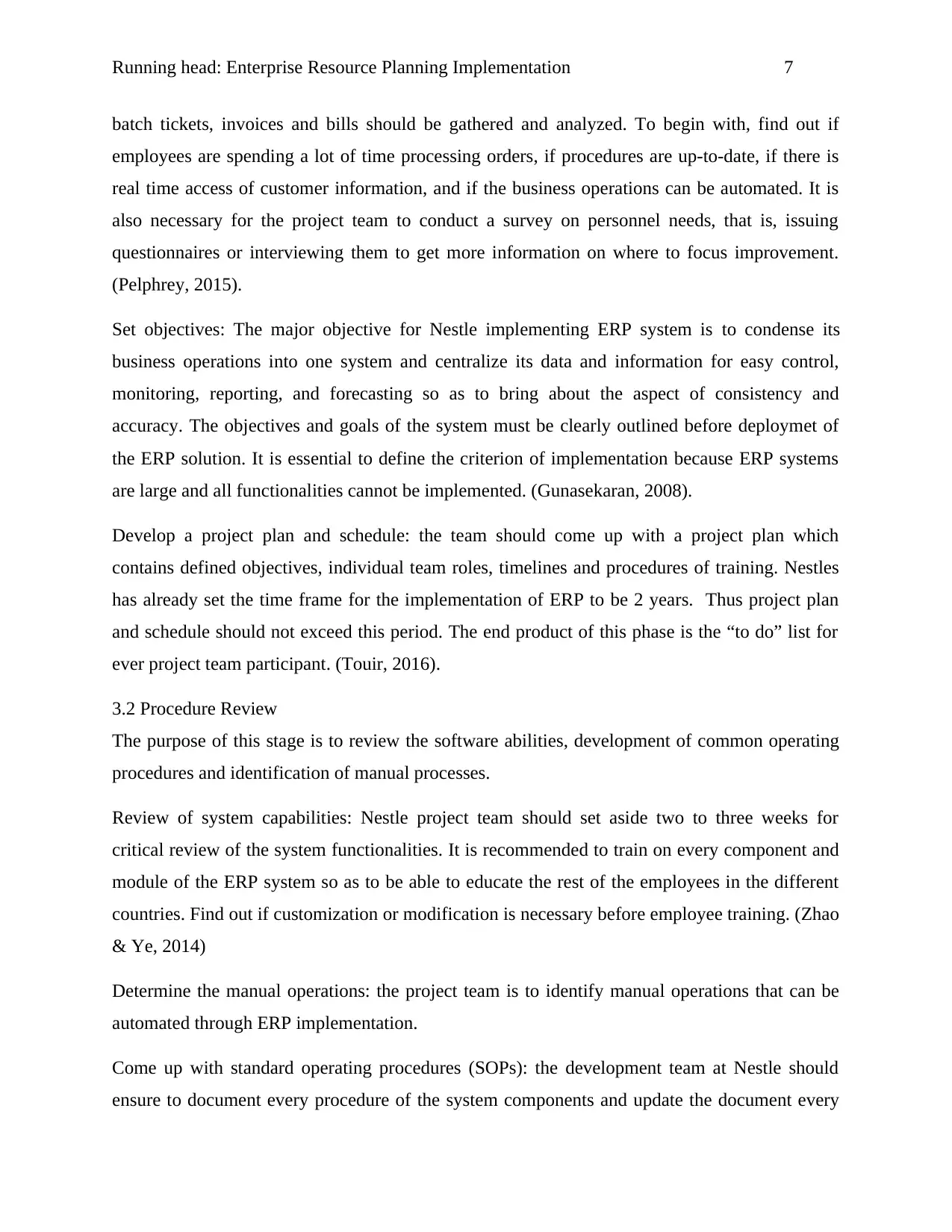
Running head: Enterprise Resource Planning Implementation 7
batch tickets, invoices and bills should be gathered and analyzed. To begin with, find out if
employees are spending a lot of time processing orders, if procedures are up-to-date, if there is
real time access of customer information, and if the business operations can be automated. It is
also necessary for the project team to conduct a survey on personnel needs, that is, issuing
questionnaires or interviewing them to get more information on where to focus improvement.
(Pelphrey, 2015).
Set objectives: The major objective for Nestle implementing ERP system is to condense its
business operations into one system and centralize its data and information for easy control,
monitoring, reporting, and forecasting so as to bring about the aspect of consistency and
accuracy. The objectives and goals of the system must be clearly outlined before deploymet of
the ERP solution. It is essential to define the criterion of implementation because ERP systems
are large and all functionalities cannot be implemented. (Gunasekaran, 2008).
Develop a project plan and schedule: the team should come up with a project plan which
contains defined objectives, individual team roles, timelines and procedures of training. Nestles
has already set the time frame for the implementation of ERP to be 2 years. Thus project plan
and schedule should not exceed this period. The end product of this phase is the “to do” list for
ever project team participant. (Touir, 2016).
3.2 Procedure Review
The purpose of this stage is to review the software abilities, development of common operating
procedures and identification of manual processes.
Review of system capabilities: Nestle project team should set aside two to three weeks for
critical review of the system functionalities. It is recommended to train on every component and
module of the ERP system so as to be able to educate the rest of the employees in the different
countries. Find out if customization or modification is necessary before employee training. (Zhao
& Ye, 2014)
Determine the manual operations: the project team is to identify manual operations that can be
automated through ERP implementation.
Come up with standard operating procedures (SOPs): the development team at Nestle should
ensure to document every procedure of the system components and update the document every
batch tickets, invoices and bills should be gathered and analyzed. To begin with, find out if
employees are spending a lot of time processing orders, if procedures are up-to-date, if there is
real time access of customer information, and if the business operations can be automated. It is
also necessary for the project team to conduct a survey on personnel needs, that is, issuing
questionnaires or interviewing them to get more information on where to focus improvement.
(Pelphrey, 2015).
Set objectives: The major objective for Nestle implementing ERP system is to condense its
business operations into one system and centralize its data and information for easy control,
monitoring, reporting, and forecasting so as to bring about the aspect of consistency and
accuracy. The objectives and goals of the system must be clearly outlined before deploymet of
the ERP solution. It is essential to define the criterion of implementation because ERP systems
are large and all functionalities cannot be implemented. (Gunasekaran, 2008).
Develop a project plan and schedule: the team should come up with a project plan which
contains defined objectives, individual team roles, timelines and procedures of training. Nestles
has already set the time frame for the implementation of ERP to be 2 years. Thus project plan
and schedule should not exceed this period. The end product of this phase is the “to do” list for
ever project team participant. (Touir, 2016).
3.2 Procedure Review
The purpose of this stage is to review the software abilities, development of common operating
procedures and identification of manual processes.
Review of system capabilities: Nestle project team should set aside two to three weeks for
critical review of the system functionalities. It is recommended to train on every component and
module of the ERP system so as to be able to educate the rest of the employees in the different
countries. Find out if customization or modification is necessary before employee training. (Zhao
& Ye, 2014)
Determine the manual operations: the project team is to identify manual operations that can be
automated through ERP implementation.
Come up with standard operating procedures (SOPs): the development team at Nestle should
ensure to document every procedure of the system components and update the document every
Paraphrase This Document
Need a fresh take? Get an instant paraphrase of this document with our AI Paraphraser
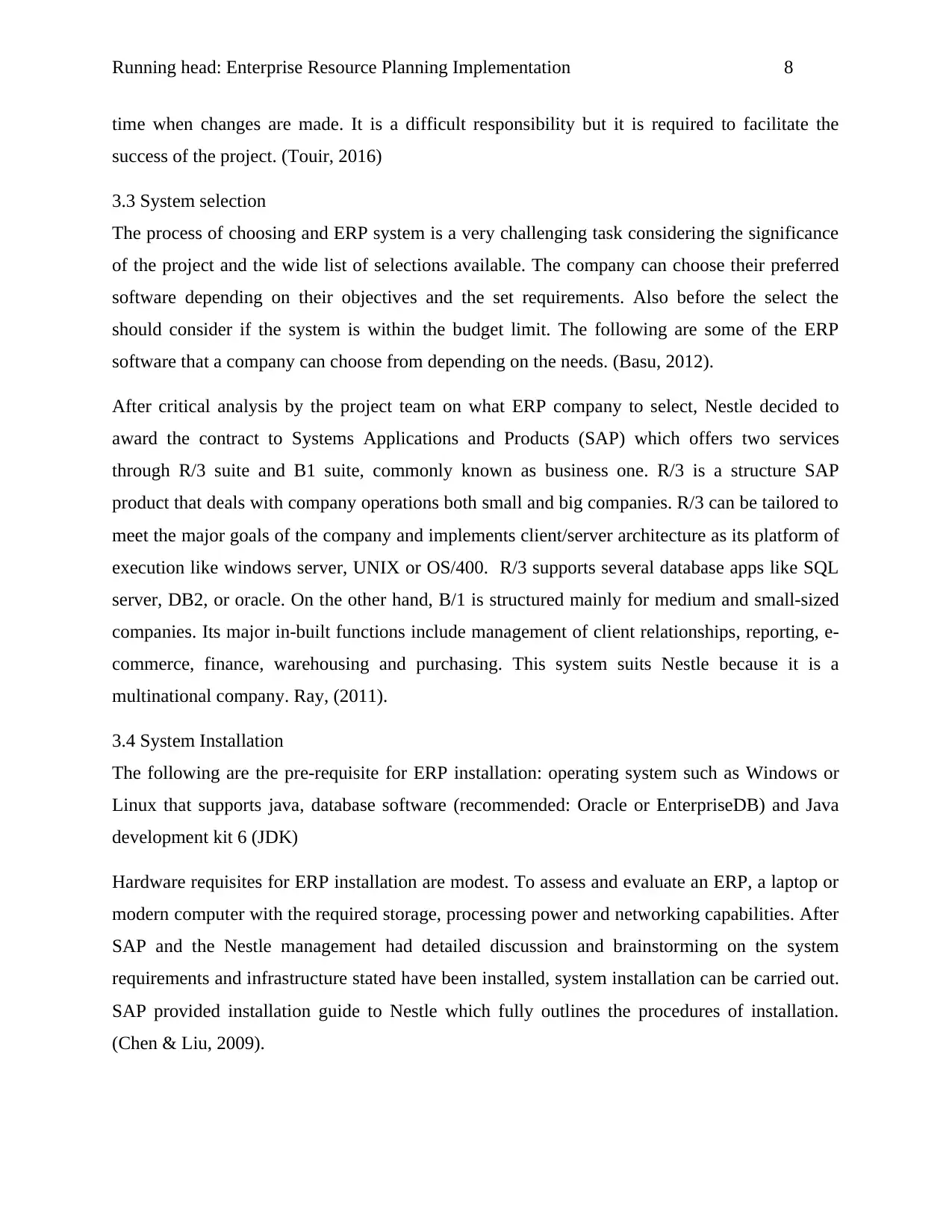
Running head: Enterprise Resource Planning Implementation 8
time when changes are made. It is a difficult responsibility but it is required to facilitate the
success of the project. (Touir, 2016)
3.3 System selection
The process of choosing and ERP system is a very challenging task considering the significance
of the project and the wide list of selections available. The company can choose their preferred
software depending on their objectives and the set requirements. Also before the select the
should consider if the system is within the budget limit. The following are some of the ERP
software that a company can choose from depending on the needs. (Basu, 2012).
After critical analysis by the project team on what ERP company to select, Nestle decided to
award the contract to Systems Applications and Products (SAP) which offers two services
through R/3 suite and B1 suite, commonly known as business one. R/3 is a structure SAP
product that deals with company operations both small and big companies. R/3 can be tailored to
meet the major goals of the company and implements client/server architecture as its platform of
execution like windows server, UNIX or OS/400. R/3 supports several database apps like SQL
server, DB2, or oracle. On the other hand, B/1 is structured mainly for medium and small-sized
companies. Its major in-built functions include management of client relationships, reporting, e-
commerce, finance, warehousing and purchasing. This system suits Nestle because it is a
multinational company. Ray, (2011).
3.4 System Installation
The following are the pre-requisite for ERP installation: operating system such as Windows or
Linux that supports java, database software (recommended: Oracle or EnterpriseDB) and Java
development kit 6 (JDK)
Hardware requisites for ERP installation are modest. To assess and evaluate an ERP, a laptop or
modern computer with the required storage, processing power and networking capabilities. After
SAP and the Nestle management had detailed discussion and brainstorming on the system
requirements and infrastructure stated have been installed, system installation can be carried out.
SAP provided installation guide to Nestle which fully outlines the procedures of installation.
(Chen & Liu, 2009).
time when changes are made. It is a difficult responsibility but it is required to facilitate the
success of the project. (Touir, 2016)
3.3 System selection
The process of choosing and ERP system is a very challenging task considering the significance
of the project and the wide list of selections available. The company can choose their preferred
software depending on their objectives and the set requirements. Also before the select the
should consider if the system is within the budget limit. The following are some of the ERP
software that a company can choose from depending on the needs. (Basu, 2012).
After critical analysis by the project team on what ERP company to select, Nestle decided to
award the contract to Systems Applications and Products (SAP) which offers two services
through R/3 suite and B1 suite, commonly known as business one. R/3 is a structure SAP
product that deals with company operations both small and big companies. R/3 can be tailored to
meet the major goals of the company and implements client/server architecture as its platform of
execution like windows server, UNIX or OS/400. R/3 supports several database apps like SQL
server, DB2, or oracle. On the other hand, B/1 is structured mainly for medium and small-sized
companies. Its major in-built functions include management of client relationships, reporting, e-
commerce, finance, warehousing and purchasing. This system suits Nestle because it is a
multinational company. Ray, (2011).
3.4 System Installation
The following are the pre-requisite for ERP installation: operating system such as Windows or
Linux that supports java, database software (recommended: Oracle or EnterpriseDB) and Java
development kit 6 (JDK)
Hardware requisites for ERP installation are modest. To assess and evaluate an ERP, a laptop or
modern computer with the required storage, processing power and networking capabilities. After
SAP and the Nestle management had detailed discussion and brainstorming on the system
requirements and infrastructure stated have been installed, system installation can be carried out.
SAP provided installation guide to Nestle which fully outlines the procedures of installation.
(Chen & Liu, 2009).
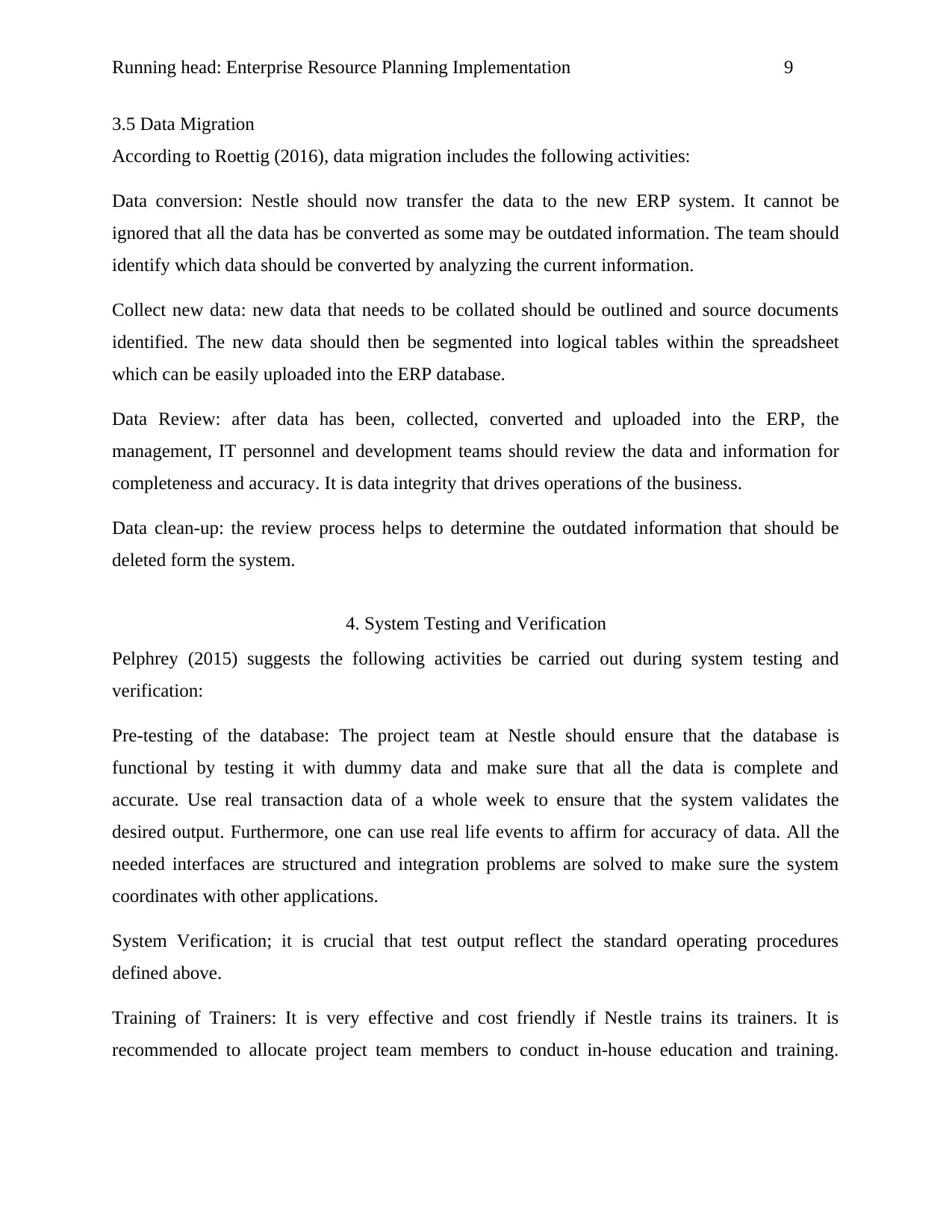
Running head: Enterprise Resource Planning Implementation 9
3.5 Data Migration
According to Roettig (2016), data migration includes the following activities:
Data conversion: Nestle should now transfer the data to the new ERP system. It cannot be
ignored that all the data has be converted as some may be outdated information. The team should
identify which data should be converted by analyzing the current information.
Collect new data: new data that needs to be collated should be outlined and source documents
identified. The new data should then be segmented into logical tables within the spreadsheet
which can be easily uploaded into the ERP database.
Data Review: after data has been, collected, converted and uploaded into the ERP, the
management, IT personnel and development teams should review the data and information for
completeness and accuracy. It is data integrity that drives operations of the business.
Data clean-up: the review process helps to determine the outdated information that should be
deleted form the system.
4. System Testing and Verification
Pelphrey (2015) suggests the following activities be carried out during system testing and
verification:
Pre-testing of the database: The project team at Nestle should ensure that the database is
functional by testing it with dummy data and make sure that all the data is complete and
accurate. Use real transaction data of a whole week to ensure that the system validates the
desired output. Furthermore, one can use real life events to affirm for accuracy of data. All the
needed interfaces are structured and integration problems are solved to make sure the system
coordinates with other applications.
System Verification; it is crucial that test output reflect the standard operating procedures
defined above.
Training of Trainers: It is very effective and cost friendly if Nestle trains its trainers. It is
recommended to allocate project team members to conduct in-house education and training.
3.5 Data Migration
According to Roettig (2016), data migration includes the following activities:
Data conversion: Nestle should now transfer the data to the new ERP system. It cannot be
ignored that all the data has be converted as some may be outdated information. The team should
identify which data should be converted by analyzing the current information.
Collect new data: new data that needs to be collated should be outlined and source documents
identified. The new data should then be segmented into logical tables within the spreadsheet
which can be easily uploaded into the ERP database.
Data Review: after data has been, collected, converted and uploaded into the ERP, the
management, IT personnel and development teams should review the data and information for
completeness and accuracy. It is data integrity that drives operations of the business.
Data clean-up: the review process helps to determine the outdated information that should be
deleted form the system.
4. System Testing and Verification
Pelphrey (2015) suggests the following activities be carried out during system testing and
verification:
Pre-testing of the database: The project team at Nestle should ensure that the database is
functional by testing it with dummy data and make sure that all the data is complete and
accurate. Use real transaction data of a whole week to ensure that the system validates the
desired output. Furthermore, one can use real life events to affirm for accuracy of data. All the
needed interfaces are structured and integration problems are solved to make sure the system
coordinates with other applications.
System Verification; it is crucial that test output reflect the standard operating procedures
defined above.
Training of Trainers: It is very effective and cost friendly if Nestle trains its trainers. It is
recommended to allocate project team members to conduct in-house education and training.
⊘ This is a preview!⊘
Do you want full access?
Subscribe today to unlock all pages.

Trusted by 1+ million students worldwide
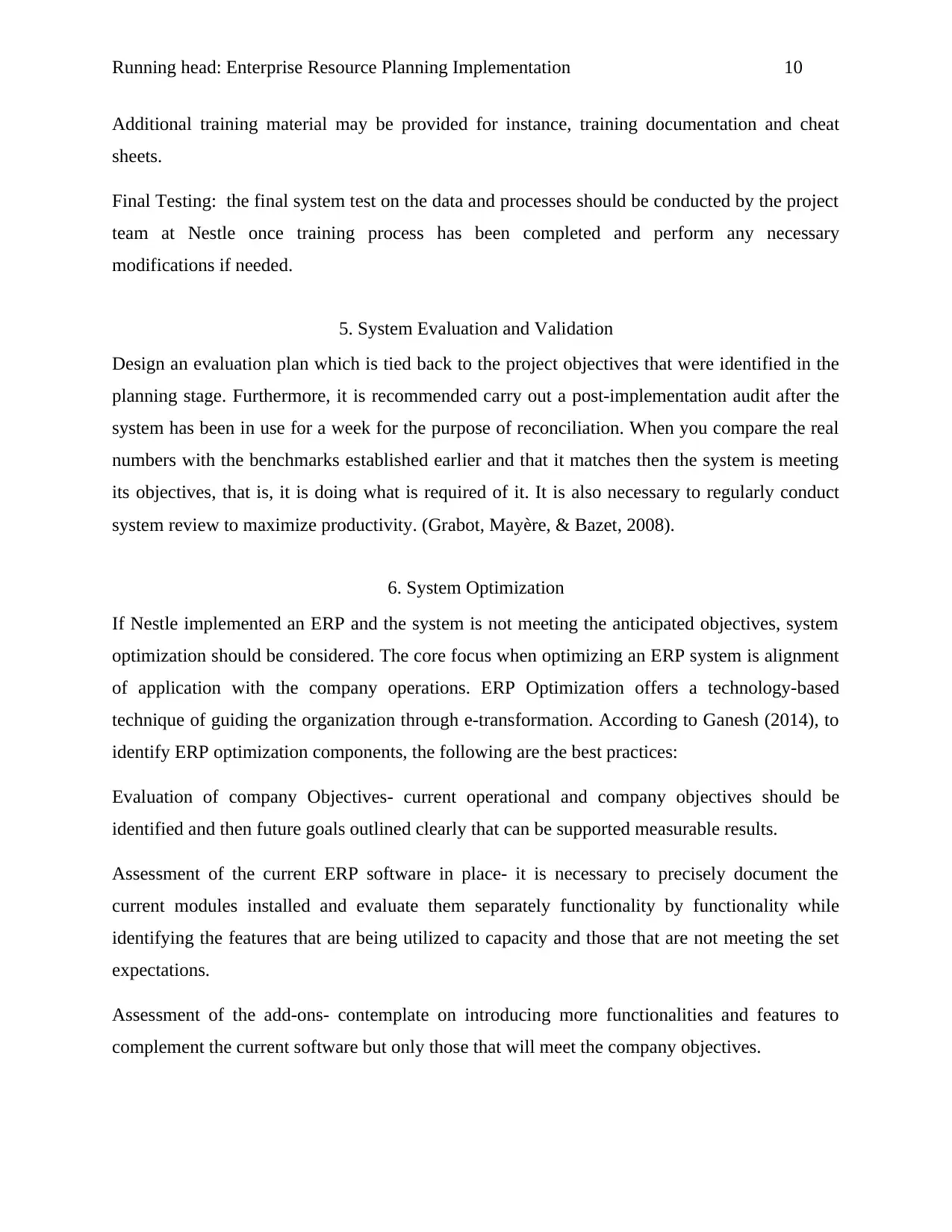
Running head: Enterprise Resource Planning Implementation 10
Additional training material may be provided for instance, training documentation and cheat
sheets.
Final Testing: the final system test on the data and processes should be conducted by the project
team at Nestle once training process has been completed and perform any necessary
modifications if needed.
5. System Evaluation and Validation
Design an evaluation plan which is tied back to the project objectives that were identified in the
planning stage. Furthermore, it is recommended carry out a post-implementation audit after the
system has been in use for a week for the purpose of reconciliation. When you compare the real
numbers with the benchmarks established earlier and that it matches then the system is meeting
its objectives, that is, it is doing what is required of it. It is also necessary to regularly conduct
system review to maximize productivity. (Grabot, Mayère, & Bazet, 2008).
6. System Optimization
If Nestle implemented an ERP and the system is not meeting the anticipated objectives, system
optimization should be considered. The core focus when optimizing an ERP system is alignment
of application with the company operations. ERP Optimization offers a technology-based
technique of guiding the organization through e-transformation. According to Ganesh (2014), to
identify ERP optimization components, the following are the best practices:
Evaluation of company Objectives- current operational and company objectives should be
identified and then future goals outlined clearly that can be supported measurable results.
Assessment of the current ERP software in place- it is necessary to precisely document the
current modules installed and evaluate them separately functionality by functionality while
identifying the features that are being utilized to capacity and those that are not meeting the set
expectations.
Assessment of the add-ons- contemplate on introducing more functionalities and features to
complement the current software but only those that will meet the company objectives.
Additional training material may be provided for instance, training documentation and cheat
sheets.
Final Testing: the final system test on the data and processes should be conducted by the project
team at Nestle once training process has been completed and perform any necessary
modifications if needed.
5. System Evaluation and Validation
Design an evaluation plan which is tied back to the project objectives that were identified in the
planning stage. Furthermore, it is recommended carry out a post-implementation audit after the
system has been in use for a week for the purpose of reconciliation. When you compare the real
numbers with the benchmarks established earlier and that it matches then the system is meeting
its objectives, that is, it is doing what is required of it. It is also necessary to regularly conduct
system review to maximize productivity. (Grabot, Mayère, & Bazet, 2008).
6. System Optimization
If Nestle implemented an ERP and the system is not meeting the anticipated objectives, system
optimization should be considered. The core focus when optimizing an ERP system is alignment
of application with the company operations. ERP Optimization offers a technology-based
technique of guiding the organization through e-transformation. According to Ganesh (2014), to
identify ERP optimization components, the following are the best practices:
Evaluation of company Objectives- current operational and company objectives should be
identified and then future goals outlined clearly that can be supported measurable results.
Assessment of the current ERP software in place- it is necessary to precisely document the
current modules installed and evaluate them separately functionality by functionality while
identifying the features that are being utilized to capacity and those that are not meeting the set
expectations.
Assessment of the add-ons- contemplate on introducing more functionalities and features to
complement the current software but only those that will meet the company objectives.
Paraphrase This Document
Need a fresh take? Get an instant paraphrase of this document with our AI Paraphraser
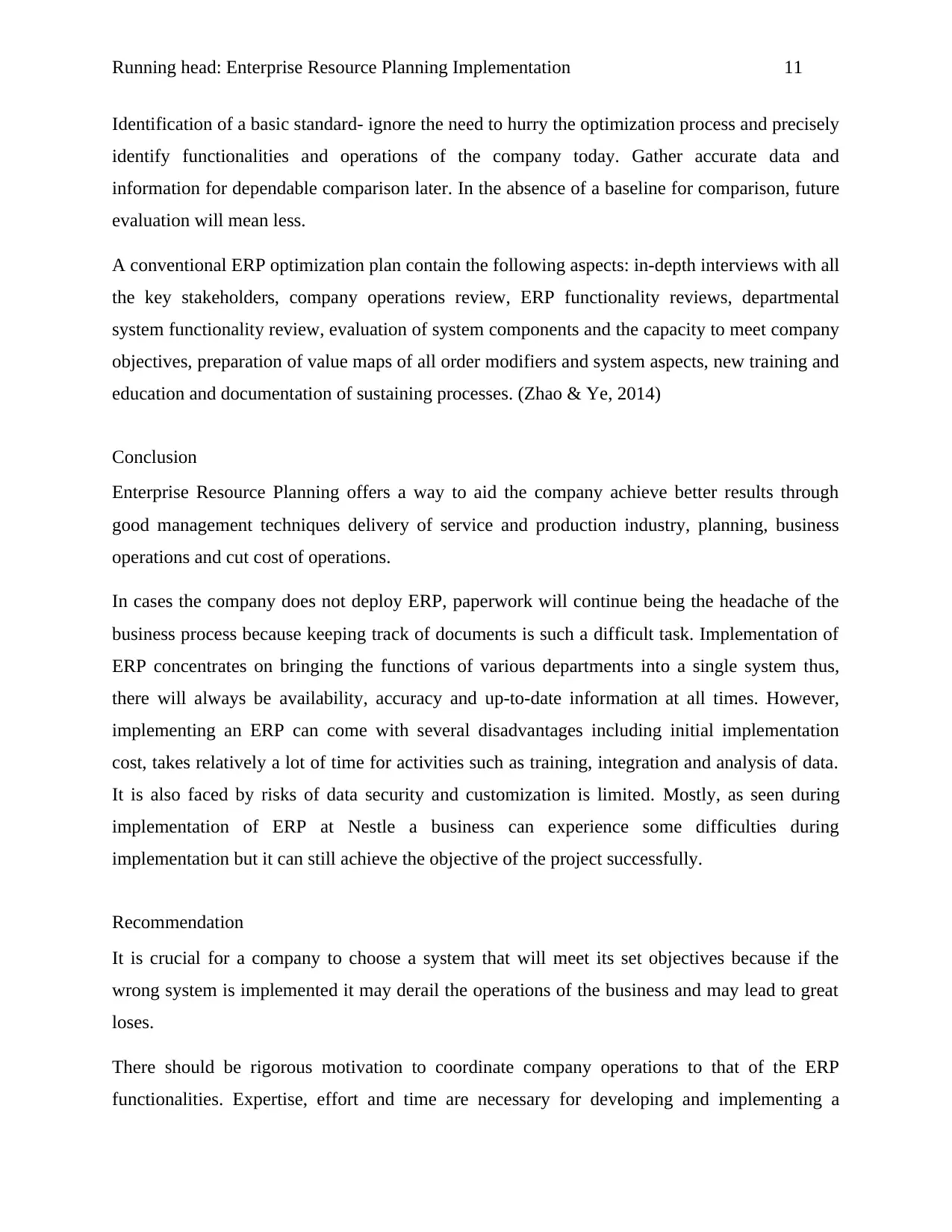
Running head: Enterprise Resource Planning Implementation 11
Identification of a basic standard- ignore the need to hurry the optimization process and precisely
identify functionalities and operations of the company today. Gather accurate data and
information for dependable comparison later. In the absence of a baseline for comparison, future
evaluation will mean less.
A conventional ERP optimization plan contain the following aspects: in-depth interviews with all
the key stakeholders, company operations review, ERP functionality reviews, departmental
system functionality review, evaluation of system components and the capacity to meet company
objectives, preparation of value maps of all order modifiers and system aspects, new training and
education and documentation of sustaining processes. (Zhao & Ye, 2014)
Conclusion
Enterprise Resource Planning offers a way to aid the company achieve better results through
good management techniques delivery of service and production industry, planning, business
operations and cut cost of operations.
In cases the company does not deploy ERP, paperwork will continue being the headache of the
business process because keeping track of documents is such a difficult task. Implementation of
ERP concentrates on bringing the functions of various departments into a single system thus,
there will always be availability, accuracy and up-to-date information at all times. However,
implementing an ERP can come with several disadvantages including initial implementation
cost, takes relatively a lot of time for activities such as training, integration and analysis of data.
It is also faced by risks of data security and customization is limited. Mostly, as seen during
implementation of ERP at Nestle a business can experience some difficulties during
implementation but it can still achieve the objective of the project successfully.
Recommendation
It is crucial for a company to choose a system that will meet its set objectives because if the
wrong system is implemented it may derail the operations of the business and may lead to great
loses.
There should be rigorous motivation to coordinate company operations to that of the ERP
functionalities. Expertise, effort and time are necessary for developing and implementing a
Identification of a basic standard- ignore the need to hurry the optimization process and precisely
identify functionalities and operations of the company today. Gather accurate data and
information for dependable comparison later. In the absence of a baseline for comparison, future
evaluation will mean less.
A conventional ERP optimization plan contain the following aspects: in-depth interviews with all
the key stakeholders, company operations review, ERP functionality reviews, departmental
system functionality review, evaluation of system components and the capacity to meet company
objectives, preparation of value maps of all order modifiers and system aspects, new training and
education and documentation of sustaining processes. (Zhao & Ye, 2014)
Conclusion
Enterprise Resource Planning offers a way to aid the company achieve better results through
good management techniques delivery of service and production industry, planning, business
operations and cut cost of operations.
In cases the company does not deploy ERP, paperwork will continue being the headache of the
business process because keeping track of documents is such a difficult task. Implementation of
ERP concentrates on bringing the functions of various departments into a single system thus,
there will always be availability, accuracy and up-to-date information at all times. However,
implementing an ERP can come with several disadvantages including initial implementation
cost, takes relatively a lot of time for activities such as training, integration and analysis of data.
It is also faced by risks of data security and customization is limited. Mostly, as seen during
implementation of ERP at Nestle a business can experience some difficulties during
implementation but it can still achieve the objective of the project successfully.
Recommendation
It is crucial for a company to choose a system that will meet its set objectives because if the
wrong system is implemented it may derail the operations of the business and may lead to great
loses.
There should be rigorous motivation to coordinate company operations to that of the ERP
functionalities. Expertise, effort and time are necessary for developing and implementing a
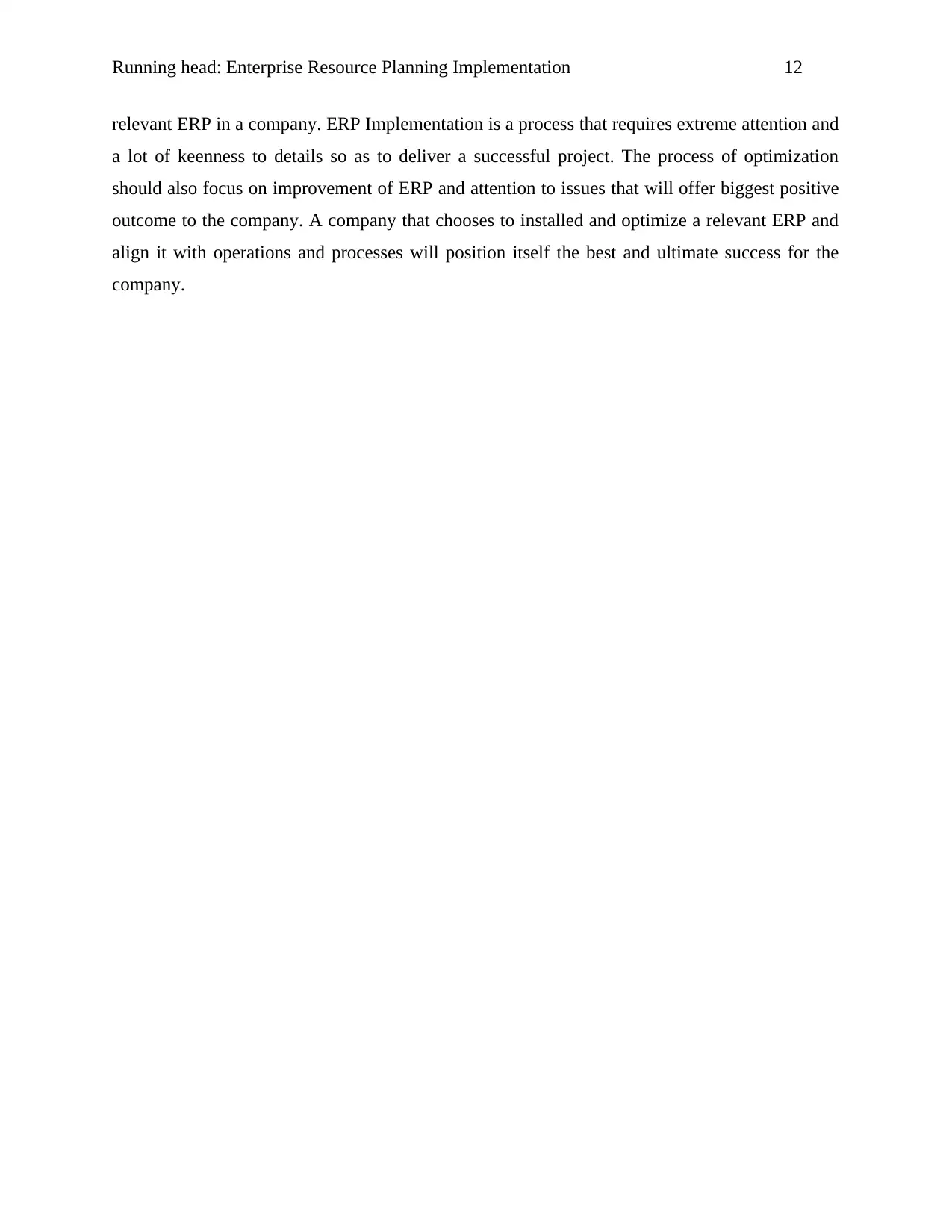
Running head: Enterprise Resource Planning Implementation 12
relevant ERP in a company. ERP Implementation is a process that requires extreme attention and
a lot of keenness to details so as to deliver a successful project. The process of optimization
should also focus on improvement of ERP and attention to issues that will offer biggest positive
outcome to the company. A company that chooses to installed and optimize a relevant ERP and
align it with operations and processes will position itself the best and ultimate success for the
company.
relevant ERP in a company. ERP Implementation is a process that requires extreme attention and
a lot of keenness to details so as to deliver a successful project. The process of optimization
should also focus on improvement of ERP and attention to issues that will offer biggest positive
outcome to the company. A company that chooses to installed and optimize a relevant ERP and
align it with operations and processes will position itself the best and ultimate success for the
company.
⊘ This is a preview!⊘
Do you want full access?
Subscribe today to unlock all pages.

Trusted by 1+ million students worldwide
1 out of 14
Related Documents
Your All-in-One AI-Powered Toolkit for Academic Success.
+13062052269
info@desklib.com
Available 24*7 on WhatsApp / Email
![[object Object]](/_next/static/media/star-bottom.7253800d.svg)
Unlock your academic potential
Copyright © 2020–2025 A2Z Services. All Rights Reserved. Developed and managed by ZUCOL.




